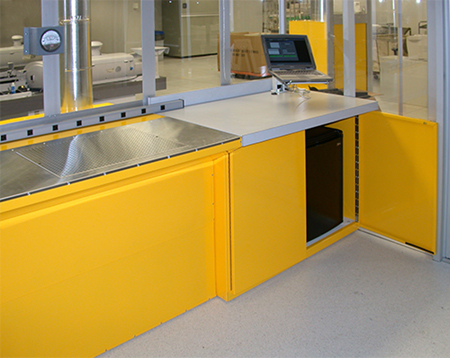D1000 Downdraft Table

in a major U.S. bank's headquarters postal facility.
This product saves lives, prevents the contamination of people and buildings, and can improve inspection rates significantly. Application areas include:
- Public and private postal examination rooms
- Customs check points
- Border patrol situations
- Homeland security applications
Manual inspection processes involving the handling and opening of postal materials, shipping boxes, luggage, handbags, and packaged merchandise pose a risk to personnel during the inspection process and to the buildings in which the inspections are being done. If an article contains a biological agent, toxic chemical or explosive or flammable material, many different types and levels of damage could occur if the material was indiscriminately released or not detected.
The D1000 downdraft table is a patented device1 designed to mitigate many of the life-threatening and/or infrastructure damaging results of such hidden dangers and is of particular value to private and governmental postal inspection facilities.
The D1000 table incorporates a perforated metal surface over which suspect articles are opened. Inside the table are powerful brushless motor-powered blowers that pull air downward into the table through the porous surface and through a 3-stage filtration system that removes large debris, respirable particulates, volatile organic hydrocarbons (VOCs), and odors: All particulates greater than 0.3 microns in size are removed with an efficiency of 99.97%. Hazardous materials such as chemicals or biologicals that are in particulate form are captured by this HEPA filter section and trapped within it. Low concentrations of many gases are stripped by the VOC filter, while extremely high concentrations of toxic or explosive gases and vapors may optionally be exhausted to a remote safe area. The D1000 has an airflow of about 28,000 liters/minute or 1000 CFM over each square meter of perforated surface, providing a strong downward air velocity of between 1.0 and 2.0 meters/second.
This approach is superior in many ways to examination systems based on upward flowing laminar flow benches; so-called ‘updraft tables.’ If cover air is forced to flow upward, aerosol materials in the inspected articles will be broadly dispersed above the table surface, leading to possible contamination of the inspector’s upper torso, the inspection area, and all materials in the immediate vicinity. Toxic or flammable gases will likewise be more broadly dispersed. The downdraft approach allows inspections to be done at low risk without the need for hot and uncomfortable face masks or protective suits.
The D1000 downdraft table may also be equipped with CBRNE monitoring equipment. Research International’s ASAP II and ASAP III threat detection systems are currently being used with D1000 tables in both government and private mail inspection facilities to monitor for a range of threat agents including biological agents, toxic chemicals, explosives and nuclear materials. For this application a proprietary sampling structure is employed that provides effective sampling across the entire table surface.
Specifications for D1000 Downdraft Table
| Characteristic | Value |
|---|---|
| Working surface area, typical | 0.61 x 0.46 meters (18 x 24 inches) |
| Downward velocity at table face | 1.7 m/sec (67 in/sec) typical; air flow is adjustable |
| Aerosol capture efficiency | 99.97% for all particles >0.3 microns |
| Gas and vapor filtration | VOC filter; optional recirculation or discharge to safe area |
| Filter design | 3-stage: Foam pre-filter + HEPA filter + activated carbon/zeolite VOC filter |
| Filter life, typical | Clean foam pre-filter when visibly compromised Activated carbon/zeolite filter: 6 months HEPA Filter: 2-5 years |
| Power | 200 watts maximum; spark-free brushless blower motor |
| Materials of construction | 24 gauge cold rolled steel body, 304 stainless perforated work surface |
| Finish | Powder-coated baked enamel; white or yellow |
| Size | 48" Wide x 44" High x 30" Deep |
| Weight | 216 lbs. |
Notes:
(1) The D1000 table is manufactured in accordance with U.S. Patent 7,377,952.
Research International, Inc. reserves the right to change specifications without prior notice.


